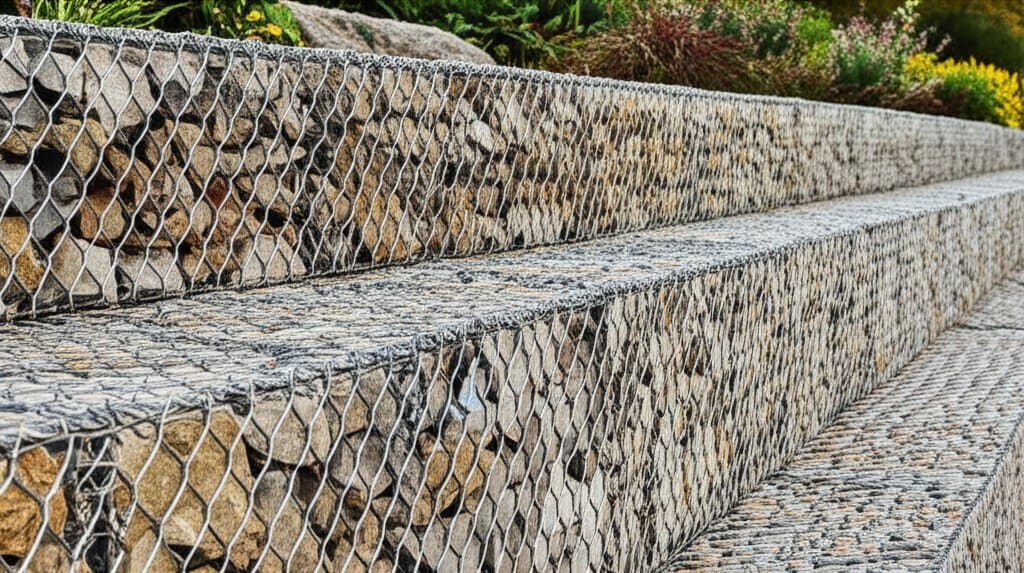Building a Strong Team for Gabion Wall Projects
Constructing a reliable gabion wall requires collaboration among skilled professionals from the outset. This teamwork ensures the project addresses site-specific challenges like soil conditions and water flow.
- Landscape architect or civil engineer: Involve this expert early to determine optimal wall heights, slopes, and integrated drainage systems. Detailed blueprints help avoid costly errors such as uneven sections or excessive material use.
- Geotechnical engineer: Essential for walls taller than four feet or those adjacent to buildings; they conduct soil tests to recommend foundation depth and load-bearing capacity.
- General contractor or landscape builder: Oversees the entire timeline, including safe excavation practices and coordination of material deliveries to prevent delays.
- Stone supplier: Verify that stones feature sharp edges, high durability, and sizes between two to six inches; avoid rounded pebbles, which shift easily and hinder drainage.
- Wire basket manufacturer: Select baskets with heavy-gauge, galvanized steel or PVC-coated wire designed to withstand corrosion for 20 years or more.
Conduct thorough background checks on all team members by requesting project portfolios. While professional oversight may increase costs by 10 to 20 percent, it minimizes unexpected modifications and ensures long-term performance.
Key Priorities in Gabion Wall Design
Focus on elements that deliver the greatest impact when developing your gabion wall plan. Prioritize functionality over aesthetics to build a structure that endures environmental stresses.
- Effective water management: Slope the ground surface away from the wall base, incorporate perforated drain pipes, and establish clear overflow channels to prevent hydrostatic pressure buildup.
- Foundation integrity: Achieve 95 percent compaction in base layers using a plate compactor, and align basket joints in a running bond pattern for added strength.
- Durable materials: Opt for weather-resistant wire mesh and locally sourced stones that tolerate freeze-thaw cycles without cracking or degrading.
- Visual integration: Choose a mix of stone colors and textures that complement your home's exterior or surrounding greenery for a seamless landscape fit.
- Supplementary features: Install LED pathway lighting or drought-tolerant plants only after confirming the wall's stability and dryness over several months.
Postpone non-essential embellishments like decorative caps until core systems prove reliable. Refrain from planting deep-rooted trees or shrubs near the wall, as expanding roots may displace baskets over time.
Step-by-Step Construction Sequence and Budget Considerations
Follow a methodical approach to gabion wall installation to optimize expenses and reduce the risk of structural issues. This sequence builds progressively, with each stage reinforcing the previous one.
- Site survey and water evaluation: Map underground utilities and analyze natural water runoff patterns to inform drainage placement.
- Excavation and foundation preparation: Dig a trench 12 to 18 inches deep, then layer and compact four inches of crushed gravel for a stable, level base.
- Install the initial row of baskets: Position and secure baskets with bracing wires to maintain squareness, filling from the rear with the coarsest stones to promote even weight distribution.
- Add backfill and drainage layers: Line the rear with geotextile fabric to block soil migration, then pack in gravel to facilitate water escape.
- Erect additional layers: Stagger seams between courses like brickwork and fasten connecting wires to prevent separation under load.
- Complete the upper edge: Secure a lid or add a stone lid for protection, or blend with soil if the wall serves as a terrace.
- Finish with grading and stabilization: Reshape the surrounding terrain to divert runoff, and seed with erosion-resistant grass or install mulch.
Rushing compaction or omitting drainage checks often results in wall tilting or failure. Budget for tools like levels and compaction equipment, as proper execution can extend the wall's lifespan by decades while controlling overall costs.
Essential Maintenance Practices
Gabion walls demand routine attention to preserve their performance, though they require far less intervention than solid concrete barriers. Regular inspections catch issues early and extend service life.
- Examine wire condition: Scan for signs of corrosion, such as discoloration or frayed connections, and replace damaged sections promptly.
- Clear drainage paths: Remove leaves, sediment, or ice from outlets and weep holes to maintain free-flowing water exit points.
- Monitor alignment: Use a straightedge or plumb bob annually to detect any shifting, addressing minor settlements before they worsen.
- Manage nearby growth: Prune encroaching roots and clear moisture-retaining vines to avoid added pressure on the structure.
- Protect the surface: Replenish topsoil or add gravel barriers to stop water from accumulating and accelerating wear.
Schedule these tasks biannually, especially after heavy storms, to safeguard your investment.
Expert Recommendations for Optimal Results
Incorporate these proven techniques to elevate your gabion wall from functional to exceptional. Attention to detail in material handling and assembly yields superior outcomes.
- Select angular stones measuring two to eight inches in diameter; their interlocking shape enhances stability and permeability.
- Tension all connecting wires firmly prior to adding stones to keep baskets perfectly aligned during filling.
- Load stones layer by layer from the base forward, rather than dumping from above, to avoid uneven settling.
- Combine stones of similar hardness, such as all granite or all basalt, to prevent gaps from uneven erosion.
- Shield the upper wire edges with a concrete cap or dense planting to minimize sunlight-induced degradation.
- Ensure a one-inch buffer of gravel or fabric separates the wire from adjacent soil to reduce abrasion.
A veteran installer from the Midwest region shared this insight: “Gabions fail where water has nowhere to go.” This principle underscores the importance of hydrology in every project.
Securing Lasting Landscape Benefits
Before engaging professionals, observe your site's water behavior during rainfall. Document pooling areas and flow directions to guide precise drainage integration. By emphasizing water control alongside sturdy construction, gabion walls not only outperform concrete in versatility but also enhance your property's resilience and beauty for years ahead.
